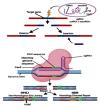Control of Plant Viral Diseases by CRISPR/Cas9: Resistance Mechanisms, Strategies and Challenges in Food Crops
- PMID: 34206201
- PMCID: PMC8309070
- DOI: 10.3390/plants10071264
Control of Plant Viral Diseases by CRISPR/Cas9: Resistance Mechanisms, Strategies and Challenges in Food Crops
Abstract
Protecting food crops from viral pathogens is a significant challenge for agriculture. An integral approach to genome-editing, known as CRISPR/Cas9 (clustered regularly interspaced short palindromic repeats and CRISPR associated protein 9), is used to produce virus-resistant cultivars. The CRISPR/Cas9 tool is an essential part of modern plant breeding due to its attractive features. Advances in plant breeding programs due to the incorporation of Cas9 have enabled the development of cultivars with heritable resistance to plant viruses. The resistance to viral DNA and RNA is generally provided using the Cas9 endonuclease and sgRNAs (single-guide RNAs) complex, targeting particular virus and host plant genomes by interrupting the viral cleavage or altering the plant host genome, thus reducing the replication ability of the virus. In this review, the CRISPR/Cas9 system and its application to staple food crops resistance against several destructive plant viruses are briefly described. We outline the key findings of recent Cas9 applications, including enhanced virus resistance, genetic mechanisms, research strategies, and challenges in economically important and globally cultivated food crop species. The research outcome of this emerging molecular technology can extend the development of agriculture and food security. We also describe the information gaps and address the unanswered concerns relating to plant viral resistance mediated by CRISPR/Cas9.
Keywords: CRISPR/Cas9; challenges; food crops; plant viral diseases; resistance mechanisms and strategies.
Conflict of interest statement
The authors have declared that there is no conflict of interest exists.
Figures




References
Publication types
LinkOut - more resources
Full Text Sources
Other Literature Sources

